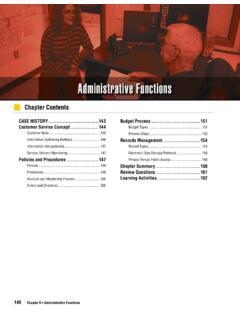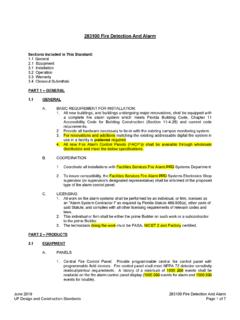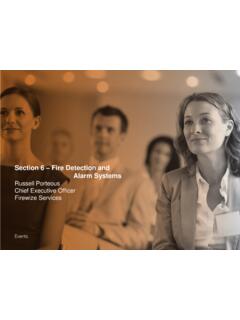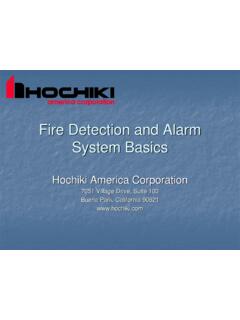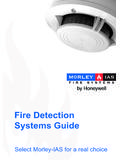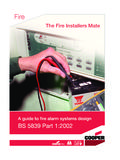Transcription of Fire Detection and Alarm Systems - IFSTA
1 604 Chapter 14 fire Detection and Alarm Systems fire Detection and Alarm SystemsChapter ContentsCase History ..607 fire Alarm system Components ..608 fire Alarm Control Units ..608 Primary Power Supply ..609 Secondary Power Supply ..609 Initiating Devices ..610 Notifi cation Appliances ..610 Additional Alarm system Functions ..612 Alarm Signaling Systems ..613 Protected Premises Systems (Local) ..614 Supervising Station Alarm Systems ..617 Public Emergency Alarm Reporting Systems ..621 Emergency Communications Systems ..621 Automatic Alarm -Initiating Devices ..623 Fixed-Temperature Heat Detectors ..624 Rate-of-Rise Heat Detectors ..627 Smoke Detectors ..629 Flame Detectors ..633 Combination Detectors ..634 Sprinkler Waterfl ow Alarm -Initating Devices ..634 Manually Actuated Alarm -Initiating Devices ..635 Inspection and Testing ..637 Inspection Considerations for fire Alarm Control Units.
2 638 Inspection Considerations for Alarm -Initiating Devices ..639 Inspection Considerations for Alarm Signaling Systems ..641 Inspecting, Testing, and Evaluating fire Detection and Alarm Systems ..642 Acceptance Occupant Notifi cation Devices ..643 Chapter Summary ..647 Review Questions ..647 Photo courtesy of Rich Mahaney. Chapter 14 fire Detection and Alarm Systems60514 Chapter ContentsKey TermsAcceptance Test ..642 Alarm Signal ..613 Central Station system ..618 fire Alarm Control Unit (FACU) ..608 Ionization Smoke Detector ..632 Mass Noti cation system (MNS) ..622 Photoelectric Smoke Detector ..630 Proprietary Alarm system ..629 Protected Premises system ..614 Public Emergency Alarm Reporting system ..621 Remote Receiving Station ..619 Service Test ..637 Smoke Damper ..612 Smoke Detector ..629 Supervisory Signal ..613 Thermistor.
3 628 Trouble Signal ..613 NFPA Job Performance RequirementsThis chapter provides information that addresses the following job performance requirements of NFPA 1031, Standard for Professional Qualifications for fire Inspector and Plan Examiner (2014). fire Inspector fire Inspector 14 fire Detection and Alarm Systems After reading this chapter, students will be able to: Inspector I1. Identify fi re Alarm system components. ( )2. Explain types of Alarm -signaling Systems . ( ) 3. Explain types of automatic Alarm -initiating devices. ( )4. Describe manual Alarm -initiating devices. ( ) 5. Describe service testing and inspection methods for fi re Detection and Alarm Systems . ( )Learning ObjectivesFire Detection and Alarm Systems Inspector I Inspector II1.
4 Explain methods to evaluate fi re Detection and suppression system equipment for life safety, property conservation and hazards. ( , )2. Describe inspection and testing methods for fi re Detection and suppression system equipment. Chapter 14 fire Detection and Alarm Systems607 Case HistoryCase HistoryryrChapter 14 fire Detection andAlarm SystemsFire Detection and Alarm SystemsAthens, Georgia, 2014: An investigation by the student newspaper at the University of Georgia revealed numerous expired fire extinguishers on campus. A total of 57 fire extinguishers in the labs, classrooms, and hallways of 19 buildings were checked; 46 of the extinguishers were expired and had not been checked in more than a year. Annual checks for many of the more than 8,000 extinguishers on campus had slowed considerably because of difficulties in contracting with an outside company.
5 After the story came to light, a company was quickly contracted to start the process of checking, servicing, and replacing extinguishers. The Safety Division was also working to implement an electronic database to keep track of the extinguishers on campus. History has proven that early Detection of a fire and the signaling of an ap-propriate Alarm remain significant factors in preventing large losses due to fire . Properly installed and maintained fire Detection and Alarm Systems can help to increase the survivability of occupants and emergency responders while decreasing property losses (F i g u r e 14 .1).Together with automatic fire suppression Systems , fire Detection and Alarm Systems are part of the active fire protection Systems found in many occupan-cies. To this end, adopted building and/or fire codes may require the instal-lation of fire Detection and Alarm Systems .
6 These Systems usually require installation and maintenance by trained individuals. Figure Large-loss res can often be prevented when there is little or no delay between Detection and Alarm 14 fire Detection and Alarm Systems This chapter provides information on the fundamental components of fire Detection and Alarm Systems . Addressed in more detail are fire Alarm control units, Detection and Alarm system components, types of signals, Alarm -initiating devices, and notification appliances. This chapter also highlights the proce-dures that fire inspectors or other personnel should follow while inspecting and testing these Systems . Also described is the importance of preparing and maintaining accurate records regarding the installation, testing, modifica-tion, and maintenance of fire Detection and Alarm Alarm Control Unit (FACU) The main fire Alarm system component that monitors equipment and circuits, receives input signals from initiating devices, activates notification appliances, and transmits signals off-site.
7 Formerly called the fire Alarm control panel (FACP).Case HistoryFire Alarm system ComponentsModern Detection and signaling Systems vary in complexity from those that are simple to those that incorporate advanced Detection and signaling equip-ment. Such Systems are typically designed and installed by qualified individu-als as determined by the AHJ. The design, installation, and approval of a fire Detection and Alarm system may also require acceptance testing by regulatory agencies before new buildings are occupied or the system is placed in design and installation of the fire Detection and Alarm system should conform to applicable provisions of NFPA 70, National Electrical Code , and N F PA 72, National fire Alarm and Signaling Code, and locally adopted codes and ordinances. Other standards also apply to the installation of these Systems and are addressed later in this chapter within the discussions of the various types of Systems .
8 Each of the following sections highlights a basic component of a fire Detection and Alarm Alarm Control UnitsThe fire Alarm control unit (FACU), formerly called the fire Alarm control panel (FACP), contains the electronics that supervise and monitor the integrity of the wiring and components of the fire Alarm system . The FACU basically serves as the brain for the Alarm system (F i g u r e 14 . 2). It receives signals from Alarm -initiating devices, processes the signals, and produces output signals that activate audible and visual appliances. The FACU also transmits signals to an off-site monitoring station when provided. Power and fire Alarm circuits are connected directly into this panel. In addition, the remote auxiliary fire control units and notification appliance panels are considered to be part of the fire Alarm system and are connected and for the system are located in the FACU (Figure , p.)
9 610). The FACU can also perform other functions, such as: Providing two-way firefighter communication Providing remote annunciator integration Controlling elevators, HVAC, fire doors, dampers, locks, or other fire pro-tection featuresThe FACU can also provide public address messages and mass notifica-tions alerts through prerecorded evacuation messages or independent voice : Some fire Alarm control units are designed for both security and fire protection. In these types of Systems , fire protection is engineered into the system to assume the highest priority. Chapter 14 fire Detection and Alarm Systems609 fire AlarmControlInitiating DevicesNotification AppliancesAuxiliary Devices:Smoke Control SystemsHood Suppression SystemsClean Agent Extinguishing SystemsDoor Release MechanismsElevator RecallFire Alarm SystemPrimaryPowerSource+Secondary PowerBatteriesGeneratorSmoke DetectorsHeat DetectorsManual Pull StationWater Flow SwitchValve Temper SwitchOff Premise Signaling(To supervising station)BuzzersBellsHornsStrobesPrimary Power Supply The primary electrical power supply usually comes from the building s main power connection to the local utility provider.
10 In rare instances where electrical service is unavailable or unreliable, an engine-driven generator can provide the primary power supply. If such a generator is used, either a trained operator must be on duty 24 hours a day or the system must contain multiple engine-driven generators. One of these generators must always be set for automatic starting. The FACU must supervise the primary power supply and signal an Alarm if the power supply is interrupted (Figure , p. 610).Secondary Power Supply All fire Alarm Systems must have a secondary power supply. This requirement is designed so that the system will be operational even if the main power sup-ply fails. The secondary power supply must be capable of providing normal, (nonalarm) standby conditions capacity and power to fully operate an Alarm condition. The time period requirements for secondary power operation capa-Figure This schematic shows the different components of a re Alarm control unit (FACU), the central hub of an Alarm 14 fire Detection and Alarm Systems bilities vary and can be found in NFPA 72.



